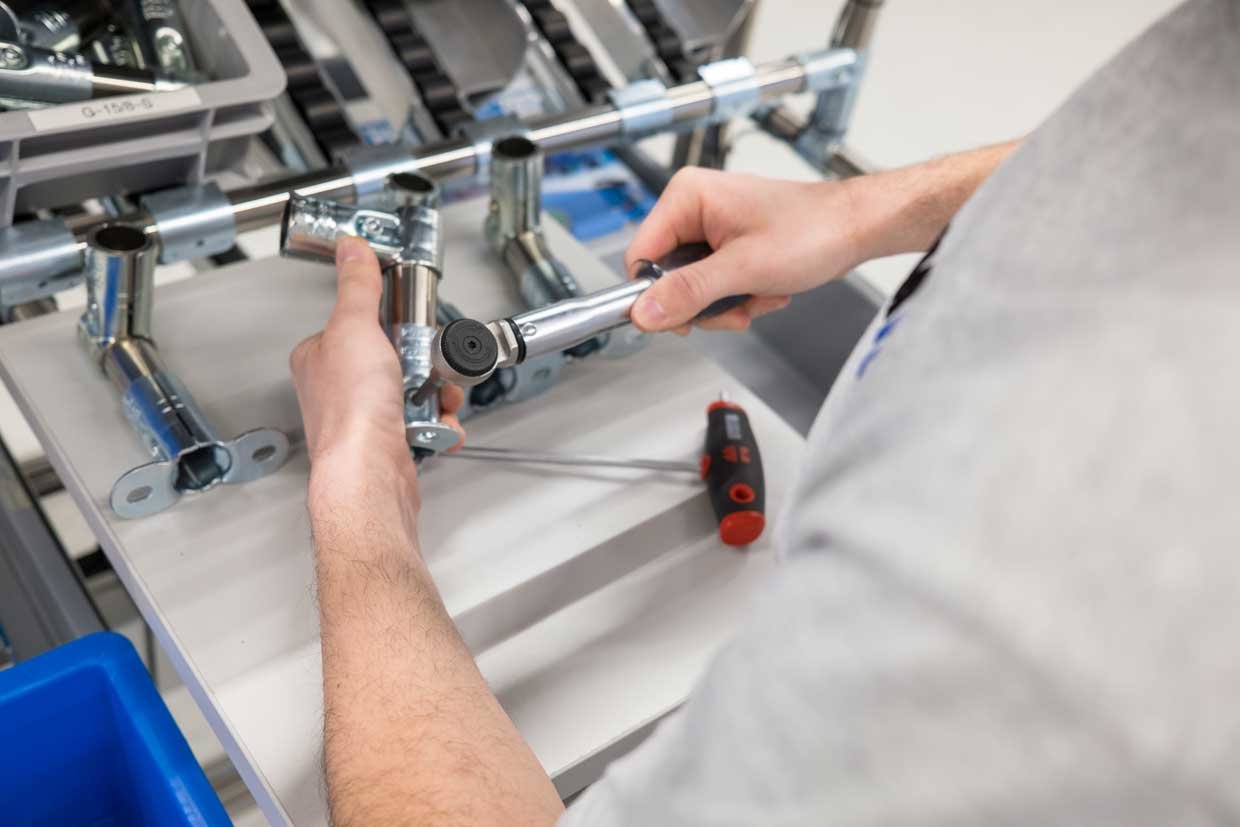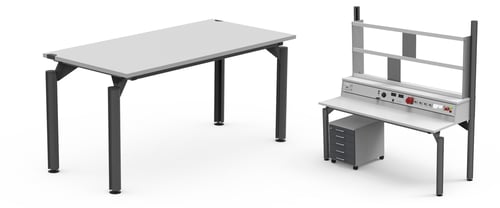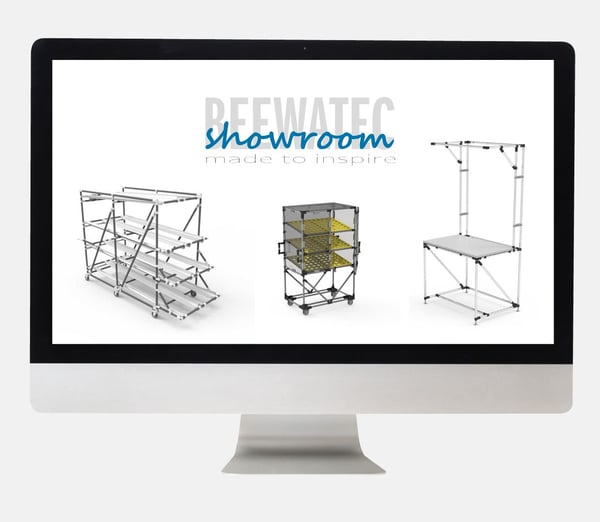5 min read
The 6S Method - How to improve the efficiency and safety of your workplace
![]() Jens Walter
:
20.Juni.2024
Jens Walter
:
20.Juni.2024
In today's fast-paced work environment, efficiency and organization are critical to the success of any business. An inefficient work environment can lead to wasted time, increased employee stress and reduced productivity.
In this article, we will look at one of the most effective methods of workspace management - the 6S method. We will explore the history of this methodology and take a detailed look at the principles, which include sorting, organizing, tidying, standardizing, systematizing, and ensuring safety. We will see how an implementation of this method can significantly improve the organization, productivity and overall performance of workspaces.
Content
- What is the 6S method? Evolution from 5S to 6S method
- Principles of 6S
- The 6S method and its advantages
- Tips for successful implementation of the 6S method
- How BeeWaTec helps you implement the 6S method in your work environment
- The future of 6S: Trends and innovations in lean management
- Conclusion
What is the 6S method? Evolution from 5S to 6S method
The 6S method has its origins in Japan and is based on the original concept of the 5S method, which began to develop in the 20th century. Japanese companies such as Toyota, Honda and Sony were among the first to use 5S principles to optimise their workplaces and processes. This concept focused on seiri ("sort"), seiton ("set in order"), seiso ("shine"), seiketsu ("standardize") and shitsuke ("sustain").
Over time, this concept evolved into the 6S method, which added a sixth element, 'Safety', focusing on the prevention and management of risks associated with the work environment. This evolution has enabled even more comprehensive and effective workspace and process management, leading to the further spread and success of the 6S methodology worldwide.

Principles of 6S
The principles of the 6S method are the key steps towards effective organization and management of the working environment:
- Sort: Removing unnecessary items from the workspace, such as sorting tools and removing unnecessary items from the workbench.
- Set in order: Organizing remaining items so that they are easily accessible, such as organizing documents into logical folders and labeling shelves.
- Shine: Keeping the workspace clean and tidy, for example, mopping the floor and cleaning the desk regularly.
- Standardize: Establishing standards and procedures for performing 6S, for example, creating a task schedule for each employee at the beginning of a work shift.
- Sustain: Implementing systems and processes that support following the 6S standards, for example, automating the cleaning of machinery and equipment with maintenance schedules.
- Safety: Managing risks associated with the working environment, for example, installing safety barriers around dangerous machinery.

DOWNLOAD NOW!
6S - Safety checklist
for companies
Download this free checklist to optimize your workplaces with the 6s method - for a self-audit for companies.
Download for free6s - Safety checklist for companies
After you have filled out and sent the form, you will receive the checklist immediately by e-mail.
The 6S method and its advantages
Implementing the 6S method brings a number of benefits that can dramatically improve the work environment and performance of a company.
The first and most important benefit is to increase the efficiency of the workspace by removing unnecessary items and arranging the remaining items so that they are easily accessible. This increases worker productivity and reduces the time wasted searching for needed materials or tools.
Another benefit is the increase in the safety of the working environment through risk management and the implementation of safety measures. Clean and tidy workplaces improve the working atmosphere and reduce the risk of accidents.
Standardization of processes increases consistency in work and reduces the likelihood of errors. The result is greater employee satisfaction, increased product or service quality and an overall increase in the competitiveness. Thus, implementing the 6S method is not only an investment in the physical work environment, but also in the success and sustainable growth of your business.
Tips for successful implementation of the 6S method
Implementing the 6S method can be the key to transforming your work environment, but proper implementation requires careful preparation and adherence to certain procedures.
Start by clearly defining the goals and expectations associated with implementing 6S in your organization. It is important to involve all team members and get their support and involvement in the process. Next, it is crucial to provide appropriate training and education for employees so that they are able to understand and apply the principles of the 6S method in their work.
Regular reviews and audits are essential to maintain the 6S system in your company. Implement feedback mechanisms and involve employees in the continuous improvement process. Maintain communication and motivate employees to adhere to the 6S standards and actively contribute to the success of the implementation of the methodology.
Example of a workstation optimized using the 6s method
- Sort: Only necessary items are in the workplace. Excess items are removed to minimize clutter.
- Set in order: Each item has a designated place, allowing for easy access and efficiency.
- Shine: Regular cleaning ensures a clean and safe environment.
- Standardize: All employees follow clear work procedures and standards for organization and cleanliness.
- Sustain: Employees are trained and motivated to adhere to and continuously improve 6S standards.
- Safety: Safety measures are integrated into all phases to minimize risks and ensure employee safety.
With the right strategy and careful planning, the 6S method can lead to significant improvements in organization, productivity and overall work environment performance.
How BeeWaTec helps you implement the 6S method in your workplace
BeeWaTec's flexible solutions and equipment can support the implementation of the 6S method in a variety of ways:
Ergonomic and modular workstations: We offer ergonomic and modular workstations that provide an efficient and safe working environment. Modular systems can be easily adapted to the specific requirements of each workplace, promoting flexibility and efficiency.
ESD design: Our ESD structures protect sensitive electronic components from electrostatic discharge. This type of equipment is crucial for environments where it is necessary to protect products and ensure the safety of workers.
Personalised designs: All designs are personalised to your requirements. We work with you to create workstations that meet your exact needs, increasing the productivity and comfort of your employees.
Additional accessories: We offer a wide range of additional accessories designed to effectively implement and maintain the 6S method. Our products include safety tow bars to ensure safe handling of equipment, and protective covers for joints, pipes and roller tracks to protect against injuries and damage. Marking elements allow clear identification and organization of the work area, perforated plates offer flexible tool organization, and lifting devices facilitate the handling of heavy loads, increasing work efficiency and safety.
Our comprehensive approaches in line with the 6S method help you create an efficient, organized and safe working environment.
The future of 6S: Trends and innovations in lean management
Further development and innovation in the 6S method is expected in the future to respond to current trends and the needs of organizations. Discussions on the future direction of the 6S method will focus on the possibilities of its further extension into new sectors and areas, including the service sector and administrative workplaces. With the rise of new technologies and the digitalisation of work processes, the 6S method is expected to be integrated into modern software tools for managing workspaces and processes.
Trends and innovations in lean management will also influence the future of the 6S method. New technologies such as the Internet of Things (IoT) and Artificial Intelligence (AI) can provide with advanced analytical tools and data-driven approaches to optimize workspaces and processes. Integrating these technologies with the 6S method can lead to even more effective management and improved performance of the work environment. Developments in lean management and technology provide endless opportunities for further development and refinement of the 6S method in the future.
Conclusion
The 6S method is not just an abstract concept, but a practical tool that can lead to significant improvements in efficiency, safety and quality of work. It is an investment in the success of the company and the overall well-being of employees. Be prepared to transform your workspace and achieve excellence with the 6S Method!
Implementing 6S with customized solutions
With our modular system you can implement any solution you need. Discover your possibilities, existing solutions or build your own material flow system with BEEVisio in 3D.




_Web_01_01.jpg?width=1240&name=Beewatec-3-(37)_Web_01_01.jpg)



